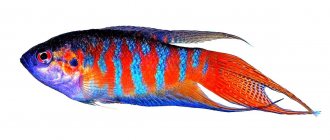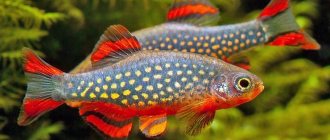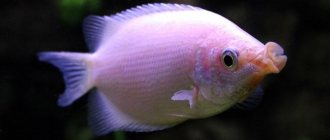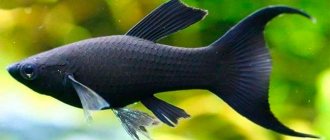Although breeding angelfish at home is not an easy task, with careful study of the issue, any aquarist can successfully solve it. However, one should not expect that a brood of these fish, called “angels” in Europe, will be obtained the first time. But given the prolific nature of angelfish, spawning should not be a problem. You just need to be patient and gradually gain the necessary experience.
Breeding in practice: the benefits of the experience gained
There are two main approaches to the issue of reproduction of “angels”. Some aquarists believe that successful hatching of eggs is possible only if they are isolated from other fish (with or without parents), while others believe that offspring can be obtained in a general aquarium.
The first option is preferable not only for the fish themselves, but also for the owner, who will be able to track all changes in their condition and behavior. Observing the spawning of angelfish allows you to determine:
- what reproductive capabilities differ between producers;
- whether eggs were laid;
- whether the eggs were fertilized;
- how soon the next spawning began.
However, it is possible to accurately judge how effective the reproduction was only after several attempts to spawn with the same pair of angelfish.
Creating ideal conditions for reproduction
It is good if the spawning of the resulting pairs occurs in separate containers. This will allow you to preserve almost the entire brood, which, being in the state of eggs, larvae or fry, is always in danger. It may be attacked by the aquarium community (including adults of its own species) who eat the eggs and fry.
The milk of males begins to ripen only if there are females nearby.
To set up individual spawning grounds, various cone-shaped objects, pipes, blocks or plates made of wood, ceramics, clay or plastic are used. The “angel” will spawn on their surface. Wide leaves of plants are also suitable for these purposes. If nothing suitable is found, the eggs will end up on the wall of the aquarium or on the equipment inside.
Preparation for reproduction
After the individuals have united in pairs, it is necessary to stimulate the beginning of their spawning. To do this, you should follow these recommendations:
- Ensure the temperature increases by 4−5°C, but not more than +32°C.
- Change the water approximately 3-4 times a week. The ratio should be 10% of the total water volume.
- The hardness of the water should be reduced using special filters or distilled water when replacing.
For successful breeding of angelfish, it is necessary to ensure an increase in temperature by 4−5°C, but not more than +32°C.
In addition to general conditions, it is necessary to ensure the availability of a place where the female can lay eggs. To do this, she chooses hard surfaces, so special objects made of wood, plastic or baked clay should be placed in the aquarium for relocation. If this is not done, the female will place eggs on the walls of the tank, and it will not be possible to move them to the incubator. When breeding angelfish in a common aquarium, it will be quite difficult to provide a separate place for laying.
The pair will independently choose a place for spawning, and when it is chosen, the fish will begin to carefully guard it. The pair will try to improve the chosen place, clearing dirt from a stone or plant leaf with their mouths or fins. By this time, the belly of the female angelfish is already noticeably rounded, and this behavior of the couple is a sign that she is ready for spawning.
Water and feeding
Angelfish are sensitive to water temperature. Increasing this indicator to 27-28°C (maximum +32°C) creates optimal conditions for the start of spawning. But before heating the liquid, it is recommended to completely refresh it and clean the aquarium.
We recommend reading
Brocade catfish pterygoplichtas
Throughout the entire period of preparation for spawning, about 10% of the water in the aquarium should be replaced 4 times a week. You can only add liquid with reduced hardness, that is, boiled.
During spawning, the angelfish should be fed exclusively with live “dishes” (daphnia tubifex, bloodworms), gradually increasing the portions. There is no need to change the composition of the menu and the dosage of the offered treats abruptly - this can lead to bloating and subsequent death of the fish.
Raising spawners and preparing for spawning
Fish that are planned for further breeding must be kept in optimal conditions. For angelfish, the water temperature is of particular importance, which should not be lower than 27°C. The second most important factor is the quality of food; future producers must eat live food (bloodworms, tubifex, daphnia, etc.) or frozen food throughout their lives. Angelfish raised exclusively on dry food are usually smaller in size, their coloration is paler, and they are often incapable of reproduction.
In good conditions, angelfish can spawn every two weeks, provided the eggs are removed immediately.
Before spawning, males and females must be kept together, since the preparation of males for spawning and the maturation of their reproductive products takes place only in the presence of females.
Spawning is stimulated by increasing the water temperature by 2°C, frequent changes (3-4 times a week, 10%), while it is better to add distilled or boiled water to reduce its hardness in the aquarium. The aquarium should contain large-leaved plants; you can also place a piece of plastic or ceramic tile there on which the angelfish can spawn. Typically, fish of this genus are not placed in a separate spawning tank, allowing them to spawn in a general aquarium.
A pair ready for reproduction can be recognized by the female’s rounded abdomen and changed behavior - future parents begin to zealously guard their territory and clean the surface on which they will spawn.
He or she: how to determine gender
The success of the entire enterprise directly depends on how healthy the breeding fish are. But even if everything is in order in this regard, then another difficulty arises: how to distinguish a male angelfish from a female.
Before the onset of puberty, there are no external differences between males and females. Only during spawning can one more or less confidently identify a female by a swollen ovipositor, and a male by a narrow and sharp genital papilla.
True, some try to find out the gender by some secondary characteristics:
- in males the dorsal fin is more elongated with 7 (or more) transverse stripes, and in females there are no more than 6 such stripes;
- The forehead of males is steep with a protruding fatty growth; in females this part of the head is slightly concave;
- The ventral fins of “boys” are slightly bifurcated at the ends, while those of “girls” are even.
However, conclusions drawn on the basis of these signs do not always correspond to the truth.
Preparing fish for spawning
When preparing for spawning, there is no need to seat the spawners. You just need to provide them with optimal conditions: water temperature 25-26 C, absence of overly active neighbors. Angelfish are tolerant of the water composition, but before spawning it is better to bring the water parameters to approximately GH 12 and 6.5. Nutrition: Some high-quality dry food (JBL Krill, TetraPro Energy) can be left, but the diet should mainly consist of live or frozen food. Freshwater bloodworms with the addition of crustaceans such as daphnia, brine shrimp, and shrimp are perfect. In small quantities you can feed with tubifex, beef heart and capelin caviar. However, you should be careful when feeding such high-calorie foods and avoid overfeeding and fattening the fish.
When it is clear that the female has accumulated eggs, you can stimulate spawning by changing the water (20% every day), raising the temperature to 27-28 C. If the fish have begun to clean the place for laying and drive away the rest of the inhabitants of the aquarium from it, you can prepare an incubator. They will most likely begin to spawn within 24 hours. But sometimes it can take several days to prepare. Also, as spawning approaches, the genital papilla becomes visible. In the male it is thinner compared to the ovipositor of females (the ovipositor has the shape of a truncated cone). Located between the anus and anal fin.
How pairs are formed
Speaking about how angelfish reproduce, it is important to note that the fish are monogamous. It is impossible to break an established couple. If the partner dies or disappears, the second angelfish spends the rest of its life alone.
However, knowing how pairs are formed in these fish, you can influence this process and spawning.
When observing fish, it is easy to notice from one to several isolated pairs. This means that the scalars themselves chose their partners from among those present. From the existing pairs, you can choose the one in which both individuals demonstrate the most striking features of their species, and use it for spawning.
But not all such unions are formed on the boy-girl principle. Some pairs are created by two females, who take turns playing the role of the male, demonstrating characteristic behavior . Later, they even imitate spawning, laying eggs that remain unfertilized.
If the purpose of breeding is selective selection, then suitable males and females are placed in a separate aquarium. The most important thing in this matter is not to waste time. Fish should be separated from the general group before they form attachments to other individuals.
We recommend reading
How do goldfish reproduce?
Breeding angelfish at home
These aquarium inhabitants can be bred in a general aquarium or in a separate spawning tank. The latter option is preferable, since this way you can achieve better safety of the offspring.
Find out who angelfish get along with in the aquarium.
In a separate spawning area
If you choose the option of moving a couple to a spawning ground, you will be able to observe from beginning to end the process of spawning and hatching of small fish from eggs. Here the female and male will not be disturbed by other aquarium inhabitants, and they will not need to be distracted by protecting the eggs.
After the female prepares the place, she begins spawning - she rubs her belly against a leaf or glass, moving upward, and leaves a transparent trail of eggs. She puts caviar in portions. The total number can range from 100 to 1 thousand eggs - their number depends on the age of the female, her state of health and living conditions.
The male then performs fertilization by releasing sperm. The spawning process can take about 2 hours.
If the owner is interested in a high percentage of survival of the young, he will need to move the clutch before dark into a separate incubator aquarium with a volume of 15–20 liters. The bottom of the incubator should be equipped with a fine mesh net.
The requirements for water quality and parameters are the same as described in the previous section. In addition, a solution of methylene blue is added to the water to prevent the appearance of fungi.
Important! White eggs (unfertilized or infected with bacteria) must be removed from the incubator daily to avoid contaminating normal eggs.
In a common aquarium
Experienced aquarists claim that breeding angelfish is not easy. It is even more difficult to do this in a community aquarium. First, the question of the safety of the caviar will arise. After spawning, both the male and female will jealously ensure that other inhabitants of the common aquarium do not harm her, but this is not always possible.
In addition, parents themselves can pose a threat to their unborn children. It has been noted that when the light is turned off, they weakly protect the eggs and can independently destroy the eggs.
Thus, when breeding fry in a common aquarium, the risk of destruction of eggs, and subsequently the fry, increases significantly. The percentage of babies hatched can be very low, or even zero.
Preparation for procreation and spawning
At first, angelfish carefully look for a place to lay their eggs. The pair carefully cleans the selected spawning ground, simultaneously driving away all unwanted guests from their territory. During this time, the female’s body manages to become more rounded, which indicates her readiness to spawn.
If the specific behavior of fish was discovered at the stage of searching for territory, then it is advisable to immediately place them in a separate aquarium until the end of spawning.
The spawning usually begins in the evening. The duration of the process is up to two hours. During this process, the mother lays eggs in chains (the number of eggs reaches 1000), which are immediately fertilized by the father.
Care of offspring
Immediately after fertilization of the eggs, the parents of the angelfish direct all their efforts to caring for the future offspring. They continuously fan the eggs with their fins, which allows them to get rid of debris, maintain a constant temperature, and ensure a flow of oxygen to the eggs.
The parents also remove all whitened eggs. Afterwards, the fish help the larvae get rid of the unnecessary shell and transfer them to a new clean place.
At the time of transfer, the larvae do not yet know how to swim, so the parents carry them independently, taking them into their mouths. Future fish remain in the new place until they become fry. Their only source of nutrition for this period is the contents of the yolk sacs left over from the eggs.
Fish eating caviar - what is the reason?
From the beginning of spawning until the offspring gains independence, the parent angelfish should not be disturbed. Stress will cause the display to stop. Moreover, they can eat all their eggs or even hatched larvae.
They also consume eggs and offspring if spawning periods occur too often and the pair requires rest. With proper care, eggs are laid every 2 weeks.
If everything is in order, the future parents will still eat some eggs, but only dead or unfertilized ones.
If nothing bothers the parent angelfish, it is enough to monitor the maintenance of optimal parameters in the aquarium.
Features of spawning in a community aquarium and why eggs turn white
If the laying of eggs took place in a common aquarium, then move them, together with the base on which they are located, into a separate container with a volume of 10-20 liters. Fill it half with regular aquarium water, the other 50% with distilled water.
It is impossible for air to affect the eggs even for a split second, so you need to move them in a small container filled with water.
If some of the laid eggs turn white after a while, this indicates that they are not alive. Perhaps the eggs with a changed color simply were not fertilized, or perhaps they were killed by a fungus or died for some other reason.
We recommend reading
What types of aquarium fish are there?
Spawning process
In most cases, this type of cichlid begins to lay eggs (give birth) in the afternoon, towards evening. The whole process takes a very short period of time and lasts a little less than an hour and a half.
The female, pressing almost closely to the surface, spawns in even rows. The male at this moment repeats the trajectory of the partner’s movement and fertilizes the tightly attached future offspring.
Provided that the eggs are immediately collected and transferred to a separate container, angelfish are capable of spawning every two weeks. In other words, a female’s pregnancy lasts on average no more than 14 days.
Angelfish can easily lay eggs in a common aquarium; if possible, move them to a separate container.
If the spawning pair nevertheless laid eggs in a common aquarium, then it is recommended to remove them and place them in a small aquarium. This must be done in order to preserve the masonry from encroachment by other inhabitants of the artificial reservoir; there is no guarantee that the spawning parents will awaken the necessary instincts and be able to properly protect the clutch. In addition, if the larvae, and then the fry, appear in the general aquarium, then preserving them will be almost impossible.
To avoid infection of future fry with fungal diseases, appropriate preparations are added to the water, for example, methylene blue (until the water acquires a clear blue tint) or Sera mycopur (a drop per liter).
It is important to keep in mind that caviar needs a constant flow of oxygen, so it is placed at a distance of approximately 2 cm from the aerator so that air bubbles do not fall on it.
To successfully complete the procedure of moving eggs from a common aquarium, the following rule must be observed: the substrate with eggs should not touch the air even for a split second. Therefore, a glass, cup or container is used, which is immersed in the general aquarium. A surface with caviar is placed there and only then transferred to a pre-prepared vessel.
The question of how many eggs a female lays at a time cannot be answered unambiguously. This indicator is very individual and depends on many external and internal factors. It is generally accepted that the average quantity is 750-900 pieces.
Arrangement of the incubator
After spawning, to prevent fungus, add methylene blue to the aquarium water with eggs or fry (the water should become noticeably blue). You will also need a heater that maintains the water temperature at +30°C.
The aerator is placed so that a light current washes the eggs, but bubbles do not fall on them. Suitable lighting is dim, but round the clock. If possible, add duckweed to the aquarium with eggs, which will regulate the content of nitrogen compounds in the water. In addition, these thickets can become a breeding ground for ciliates and rotifers, which will be used as food for the fry.
A day after moving the eggs, use a pipette to remove the eggs that have spoiled. After this, no intervention is required. All that remains is to wait until the fry hatch and take on their final form.
Incubator equipment and egg development
Angelfish, like other cichlids, care for their offspring, but their parental instinct is not so strong, and this care usually lasts only 2-3 days. Having spawned, the spawners begin to protect the eggs from other fish in the aquarium, fan the eggs with their pectoral and dorsal fins, pick up the eggs that have fallen from the substrate and eat the white ones. In some cases, they take care of their offspring until they begin to feed on their own. I must say that this care is very useful for the fry. But, unfortunately, such exemplary behavior is rather an exception to the rule, and usually producers simply eat the eggs a few hours after spawning or after dark. Therefore, if you do not want to risk finding out how caring parents your angelfish are, it is better to transfer the eggs to a separate aquarium 2-3 hours after spawning.
An incubator for caviar is prepared as follows: a small aquarium with a capacity of 5–10 liters is half filled with water from the aquarium where the breeders are kept. The second half is added with distilled water. A heater set to a temperature of 30°C and an air sprayer are placed in the incubator, and after an hour, the substrate with eggs is lowered into it so that the eggs are washed by the current from the sprayer, but air bubbles do not fall on it.
To prevent fungal infection of eggs, add methylene blue to the water until it turns intensely blue or Sera mycopur at the rate of 1 drop per liter. It is useful to place small plants in the incubator, such as duckweed or riccia, they will act as a biofilter, preventing the level of nitrogen compounds in the aquarium from jumping when the fry begin to grow quickly. In addition, ciliates and rotifers will multiply in the thickets, which will then become food for the fry. Lighting should be around the clock. Even if there are no plants in the incubator, you should leave the night light on at night.
The next day, the whitened eggs are removed with a pipette.
An adult angelfish along with its offspring.
Artificial care for young fish
Place the numerous young fish obtained after spawning in separate containers so that there are no more than two fry per liter of liquid. During this period, the water is changed every day, and at least 1/3 of the total volume must be replaced, simultaneously cleaning out the food remaining after meals.
As they grow, young individuals are again placed in separate tanks. The criteria become stricter, up to 5 liters per head, as they grow greatly and take on the shape characteristic of angelfish. Until this age, the fry are similar to ordinary small fish, without specific characteristics.
Even under ideal conditions, at least 1/5 of the total number of fry will die.
Features of the diet of babies
The first thing the fry eat is ciliates (also called live dust). In the future, specialized feed is used to raise them. However, it is not recommended to give the fry exclusively dry food. This impairs their growth, makes the color less bright, and provokes infertility.
The diet of baby angelfish should consist of frozen and live food. Next, the fry menu is supplemented with brine shrimp, and at one and a half months of age they are offered chopped tubifex and chopped bloodworms.
Small fish need to be fed up to 6 times a day, otherwise the lack of food will negatively affect their development.
From the moment the eggs are laid after spawning until the larvae appear, 2-3 days pass. Their transformation into fry occurs after another 1-1.5 weeks. At this moment, the signs of the species are already clearly visible in the babies.
If you liked the article, like and share the link on social networks. Be sure to leave comments if you have experience breeding angelfish.











